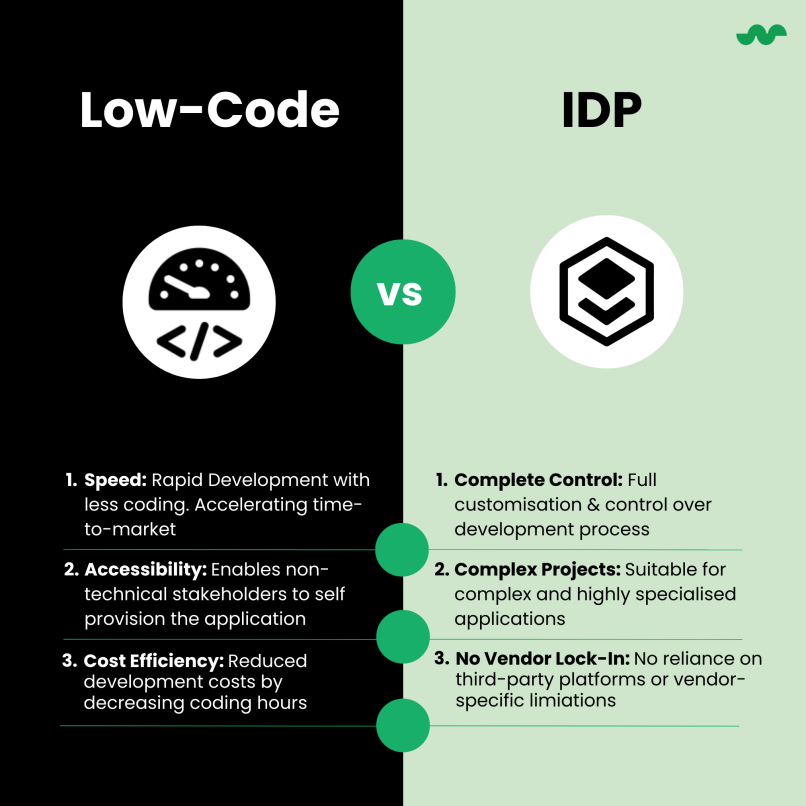
Low-code or Internal Platform?
Low-code Platforms and Internal Development Platforms (IDPs) are both tools used for creating software applications,
but they have different purposes and characteristics. Internal development platforms refer to the suite of tools, technologies, and
frameworks that organisations implement for their in-house software development. Whereas Low-Code
Platforms are
designed with the purpose of enabling users with lower levels of software development skills to create solutions with minimal coding
experience.
A major difference between IDPs and Low-Code Platforms, is IDPs have a higher degree of control and flexibility provided over the
development process. This means developers can create custom-tailored solutions that align with the specific needs.
Speed of Development
One of the benefits of IDP’s over Low-Code is the complete control and customisation of the project, however this requires a higher level of
coding skills. Internal Development Platforms require traditional coding practices and development practices, which typically takes more
time than a Low-Code Platform because software developers need to write the code for the software solution. In contrast, Low-Code Platforms
allow for rapidly built applications because users can build solutions without
writing as much custom code through the platform’s toolset. Therefore, prototyping, iterating, and delivering the project is quicker.
Codebots
The team at WorkingMouse uses their in-house Internal Development Platform ‘Codebots’. Codebots models the
development artefacts, enables standards, and enhances software quality, empowering all stakeholders to contribute. What sets
Codebots IDP apart from
low-code solutions is that developers can customise the code written by the bots, enabling them to benefit from the best of both worlds: the
reliability of off-the-shelf software and the flexibility of customised builds, all without any vendor lock-in.
• Compliant with ISO27001 standards
• Conforms to OWASP top 10 requirements
Checkout more benefits of Codebots and our toolset.
Customisation and Complexity
IDP’s are traditionally used by experienced developers who have a strong understanding of programming languages,
software design principles, and development best practices. Furthermore, IDP’s provide the full customisation ability and are able to handle
complex and specialised applications. This platform is better suited to a project where control is required over every aspect of the
software. The types of projects that IDP’s can accommodate are broad, ranging from the development of simple web applications to the
creation of complex enterprise software systems. For a more comprehensive understanding of Internal development Platforms, refer to
our blog on ‘The Rise of Internal Development Platforms’.
Whereas Low-Code Platforms are also designed to be user-friendly in the sense that they require less coding
expertise. This allows for Business analysts and other non-technical stakeholders to use Low-Code Platforms to create applications without
programming knowledge. Moreover, Low-Code Platforms are better suited to project types such as Robotic Process Automation, workflow
automation, and basic business process applications.

In addition, despite their name, Low-Code does not mean 'no-code'. Low-Code Platforms are increasingly employed by Software Developers
to streamline the development process. These platforms offer a plethora of tools, ranging from visual development
interfaces to advanced configuration capabilities, all geared towards expediting development. The focus is shifted, enabling developers to
hone in on high-level logic and solutions rather than delving deep into extensive lower-level coding.
However, developers still need to operate within the boundaries set by the specific low-code platform. For citizen developers, these
boundaries can be advantageous, offering a navigable system. Yet, for technical developers pursuing direct solutions, these constraints can
be limiting. The inherent complexity and obfuscation of Low-Code Platforms illustrate that while they excel in simpler applications, they
can falter when intricate customisations arise. The very features that expedite one project's development could hamper innovation in another
due to the platform's innate limitations.
Conclusion
Both Internal Development Platforms (IDPs) and Low-Code Platforms offer unique approaches to software development. While IDPs demand a more
manual coding effort, affording greater control and precision, Low-Code Platforms aim to streamline the development process with built-in
tools and features, making it accessible even to those with minimal coding experience.
The decision between employing a Low-Code Platform or an IDP hinges largely on the nature of the project at hand:
• Complexity: Is the project straightforward, or does it demand intricate, tailored solutions?
• Skill Availability: Does your team possess deep coding expertise, or are you looking for tools that simplify
the process?
• Project Timeline: Is rapid development and deployment a priority?
• Customisation Level: How much control and customisation is essential for project success?
Remember, in some scenarios, the most effective approach might be a blend of both platforms, utilising the strengths of each to achieve
project objectives seamlessly.
















.png)

